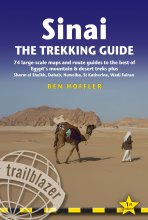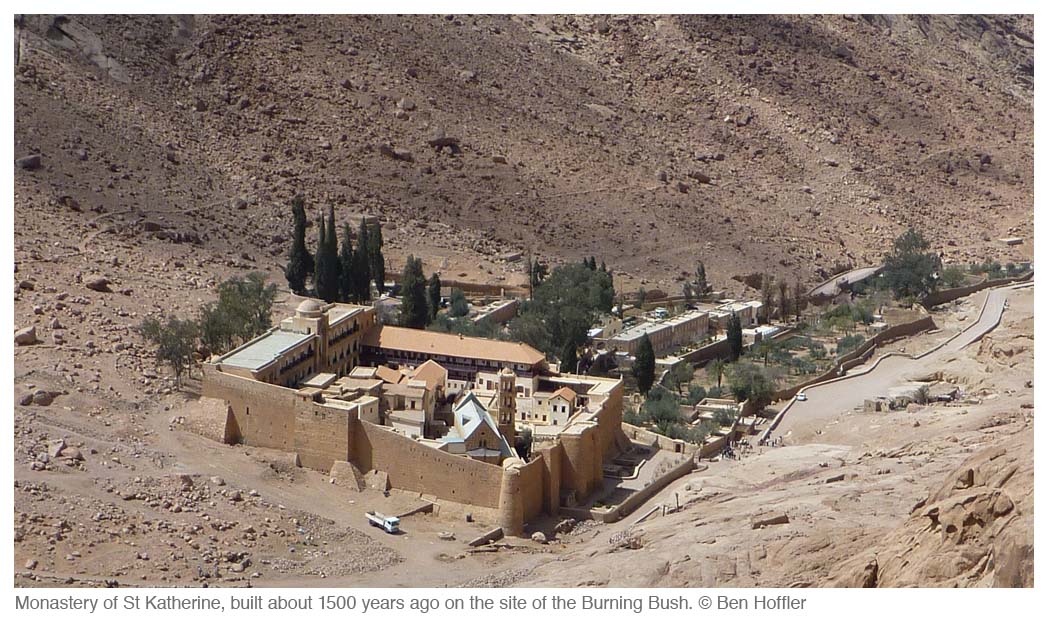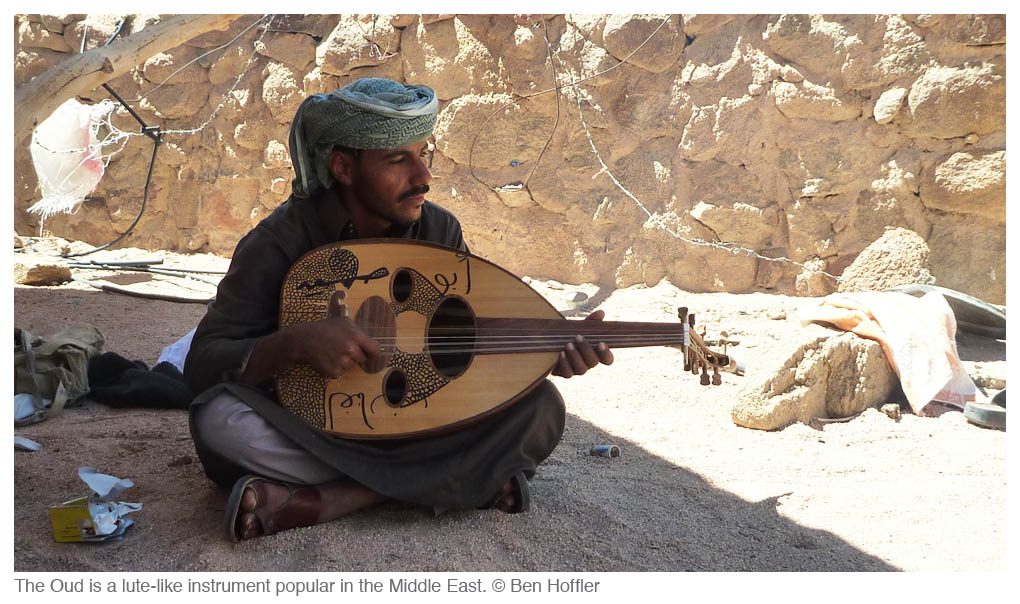'These human-scale books, written and published by people who genuinely know and love their subject, are perfect for travel's post-pandemic recovery.'
— The Guardian, March 2021

Sinai - The Trekking Guide
Excerpt:
High Mountain Region
Contents | Introduction | Planning your trek | When to go | Route options | Sharm el Sheikh | High Mountain Region | Sample trek: Jebel Berqa | Sinai desert trekking routes map
High Mountain Region
The High Mountain Region is an area of red granite peaks around St Katherine. Egypt’s highest summits are found here, with some looking to both Africa and Asia. The landscapes resonate with Biblical fable and ancient Christian ruins stand scattered across the mountainsides. It’s the most-popular trekking region in the Sinai but that’s not to say it’s crowded; far from it.
Mount Sinai aside, trekkers only come in the hundreds every year and most stick to the best-known trails. On some treks you won’t see any other trekkers at all. Even if you don’t make this area the focus of a trip you should at least spend a bit of time here. You’d miss out otherwise.

TRIBES AND TREKKING
High Mountain Region
The High Mountain Region is Jebeleya territory and every guide must be a local tribesman. There’s a special guide-rotation system here, known as the dor. Each guide has a place; he waits his turn, does his job, then goes back to wait again. The system chooses the guide — not you. To take your own you’re supposed to pay twice over: the one you take and the one who was scheduled to work.
Some trumpet this system as a model of fairness, but it’s not. First of all, it’s a bad deal for trekkers. It’s reasonable to expect a choice in something you pay for; especially something as important as a guide (and not least when guides often cost more here than elsewhere). It’s frustrating for guides too. It stops them working when they’re in demand and hinders the building of long-term relationships with trekkers. Furthermore, all guides are rewarded equally; the guides who burn the midnight oil to learn a language and read up on history, culture and wildlife get the same as those who don’t care a jot.
Whispers of discontent have become a steady chorus of protest in recent years and Jebeleya Sheikhs are well aware of the problems. Change is said to be coming and some Bedouin camps are already starting to use their own guides (eg Desert Fox Camp). Hopefully, it’ll be replaced in 2013.

Finding a guide
First of all, ask for the latest on the dor (see above). If you still have to use it the chances are you’ll get a guide you’re happy with. It’s run by the Sheikh Mousa Mountain Tours Office at the Bedouin Camp and Guesthouse. Go through this or any other agency to arrange. An industry has grown up ‘outside this system’ too and guides can be found on a casual basis. These guides are as good as any and you can choose your own and pay less. It might be preferable in many ways but it’s not advisable. If caught you can get into trouble with the tribe and it’ll be an even bigger problem for your guide.
Remember you can still take a guide by working within the system. The following are a few of the many good ones worth tracking down:
- Faraj Ahmed (mob tel 0122-678 9869) Experienced guide, good English and excellent knowledge of local plants and wildlife.
- Ahmed Saaleh Awad (mob tel 0122-351 4898, sinaigold@yahoo.com) Expert in herbal medicine with good English.
- Nasr Mansour (mob tel 0122-930 6533) Experienced guide, good English.
- Ramadan Musa Saalih Abu Ghalaba (mob tel 0100-820 3221, www.sinaimylove.com) Young but good, experienced guide with fluent English.
- Metowah Abu Musaad (mob tel 0109-590 3269, metaw2005@hotmail .com). Another young guide with superb English. Based in Dahab.
- Mohammed Eid (mob tel 0100-977 3329). Speaks good English.
- Suliman el Henehy (mob tel 0100-914 1766, suliman3020@yahoo.com). Experienced, affable guide with excellent English.
- Salema Eid (mob tel 0100-735 9622). Excellent guide who loves to explore new places. Divides his time between St Katherine and Slovenia.
Jebel Umm Shomer
Jebel Umm Shomer is in Aulad Said territory and it’s best to use their guides and cameleers. A few tribesmen live in St Katherine but they’re hard to track down (the best place is the Mohammed Salem Cafeteria, mid-morning, see box p130). Even if you find one, few speak English and this trek is thus always best organised through a local agency.
Trekking agencies
Guides and treks are best organised through local camps or agencies. They’re listed on p11 and should charge the rates on the following page.
Trekking costs
Jebeleya costs vary but reckon on paying LE100-150 a day for basic guide fees: prices rise as routes get longer or more difficult. On top of this there’s a Sheikh’s permission fee, usually about LE80-100 a day, meaning the basic cost will be around LE180-250 per day. Camels are LE80-120 a day when needed. These prices won’t always include food so factor extra in for this.
Through an agency, Aulad Said fees are about the same (but usually LE120-150 per day if you do it independently). For the Jebel Umm Shomer route you usually have to pay for jeeps both ends of the trek. Guides might ask for an extra day’s pay for the return trip at the end too.
ST KATHERINE
St Katherine (‘Katreen’) nestles at the heart of the High Mountain Region and is the highest town in Egypt. The area has an ancient Christian history but the town itself is a mostly modern creation, developed from the 1970s. It has a strong Bedouin feel and makes an excellent trekking base.
Most trailheads start out of town and it’s an important service hub for the interior, having at least one of all the main services you need.
What to see and do
The Golden Calf (El Bagara) The Israelites made the Golden Calf as an idol when Moses was on Mount Sinai. He smashed the Tablets of Law in anger when he returned to see them worshipping it (the second commandment expressly forbid idol worship). There’s a rock shaped like a calf (see map p128) on the road between the monastery and town which monks say was used to make the idol. Look out for a small black pothole in the rocks. This is the calf’s eye and the rest of its form unfolds easily thereafter.
St Katherine Protectorate Visitor Centre This small, EU-funded initiative is one of South Sinai’s few museums. It has superb exhibitions on the local environment and culture, each housed in its own stone hut. A caretaker takes you round to unlock them. Free trail guides are available for walking routes around town too, all well worth picking up. The centre (see Map 1, p128; 9.30am-1.30pm, except Fri and Sun; admission free) is just off the main road out of town.
The Blue Mountain (or Blue Desert) Belgian artist Jean Verame painted outcrops blue here to celebrate Egypt’s historic peace with Israel (it took two years to get the go-ahead, then ten tons of paint). They’re dotted across the beautiful Plain of Sened, like a gigantic, open-air art installation. Many Bedouin preferred it as it was before, but it’s still worth a look. The site is about 10km out of town and a jeep costs LE200-300. You can also hire a guide and walk over the low pass of Naqb Dhirwa, from Wadi Sebaiya.
Have a swim The Catherine Plaza (see map p128) lets non-guests use its pool for LE40 and it’s great for a plunge after a long summer trek.
The Monastery of St Katherine The monastery (daily 9am-noon excl Fri & Sun, public holidays and Christian festivals) dates from the 6th century and is a UNESCO World Heritage Site. It’s said to be the oldest working Christian monastery in the world (though monks at the Monastery of St Anthony in Egypt’s Eastern Desert would disagree). No visit to St Katherine would be complete without a trip here and it works well after the Mount Sinai trek.
The Katholikon (‘Church of the Transfiguration’) is the main church, dating back to 542ad. It was built on the site of an earlier chapel that some say was founded by the Emperor Constantine’s mother, Helena, in the 4th century. Here is a run-down of its most interesting features:
The outer doors of the Narthex (entry porch) were made by 11th century Crusaders and their graffiti is still seen: shields, coats of arms, crosses and cherubs. The next doors lead into the main church area and date from the 6th century, when the monastery was founded. They’re made from Lebanese cedar wood and show the birds and flowers of paradise.
There are 12 columns in the Nave (main church area), and each represents a month of the year. Icons above each column show the month’s special saints. The screen at the end of the nave is called the iconostasis. It’s made of carved, gold-plated wood and dates from 1612. Down the side aisle on the left there’s a small wooden shrine with a bone in it. Monks say this is the toe bone of St Katherine, found with the rest of her remains in the 9th century.
The Mosaic of the Transfiguration decorates the ceiling behind the iconostasis and is perhaps the most celebrated mosaic in the Eastern Orthodox Church. Jesus is in the middle with Moses standing to his left and Elijah his right. The Transfiguration was the event in which Jesus is said to have appeared divinely radiant on a mountain. The sun strikes his golden face through the windows every morning, re-creating the fabled scene.
The Apse has the church altar and St Katherine’s gold-plated sarcophagus. The monks sometimes open it to show her relics to Orthodox Christians. Nearby is the Chapel of the Burning Bush, around which the monastery was originally built. This is the holiest spot in the Sinai and entry isn’t usually permitted.
- Other things to see The Katholikon is just a small part of the monastery complex. The rest is mostly closed but there are still a few things to see.
Skulls, hands and shin bones of monks stand piled high in the ossuary (skull house). Burial space was limited in the rocky ground so bodies were left to decompose before being exhumed and replaced with new ones. Unfortunately, this was closed to the public recently, but it might open again.
The monastery escaped the ravages of European iconoclasm and now has the finest collection of icons anywhere in the world. They’re displayed in the monastery museum along with relics such as ivory staffs, silver croziers, holy chalices and a copy of the pledge of security it’s said the Prophet Mohammed gave the monks in the 7th century (see p67).
There’s a bush that people mill around near the Katholikon. This isn’t the Burning Bush itself, but monks say it was planted from original cuttings. The lower branches are usually stripped bare by tourists.
There’s also a small, makeshift mosque. One story goes the monks hobbled it together themselves, after hearing Caliph al Hakim was racing for the monastery in a destructive frenzy, having sacked the Church of the Holy Sepulchre in Jerusalem. They hoped that in consecrating the ground for Muslims, they’d avoid his wrath. Actually, its history is uncertain; it was probably built in less-dramatic circumstances, on the request of Hakim’s successor, Caliph el Afdal, in the early 12th century.
Sinai - The Trekking Guide
Excerpts:
- Contents
- Introduction
- Planning your trek
- When to go
- Route options
- Sharm el Sheikh
- High Mountain Region
- Sample trek: Jebel Berqa
- Sinai desert trekking routes map
Price: £14.99 buy online now…
Latest tweets